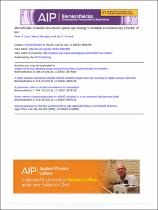 ResearchSpace
ResearchSpace
Microfluidic channel structures speed up mixing of multiple emulsions by a factor of ten
JavaScript is disabled for your browser. Some features of this site may not work without it.
- ResearchSpace
- →
- Research Publications/Outputs
- →
- Journal Articles
- →
- View Item
| dc.contributor.author |
Land, KJ

|
|
| dc.contributor.author |
Mbanjwa, M

|
|
| dc.contributor.author |
Korvink, JG

|
|
| dc.date.accessioned | 2014-10-24T13:19:01Z | |
| dc.date.available | 2014-10-24T13:19:01Z | |
| dc.date.issued | 2014-09 | |
| dc.identifier.citation | Land, K.J, Mbanjwa, M and Korvink, J.G. 2014. Microfluidic channel structures speed up mixing of multiple emulsions by a factor of ten. Biomicrofluidics, vol.8, pp 054101(1) -054101-(11) | en_US |
| dc.identifier.issn | 1932-1058 | |
| dc.identifier.uri | http://research.microsoft.com/en-us/um/people/pkohli/papers/rrmk_iui2014.pdf | |
| dc.identifier.uri | http://hdl.handle.net/10204/7729 | |
| dc.description | Copyright: 2014 American Institute of Physics (AIP). Published in Biomicrofluidics, vol.8, pp 054101(1) -054101-(11) | en_US |
| dc.description.abstract | We present a novel use for channel structures in microfluidic devices, whereby two two-phase emulsions, one created on-chip, the other off-chip, are rapidly mixed with each other in order to allow for the coalescence of one emulsion with the other. This approach has been motivated by the difficulty in introducing aqueous cross linking agents into droplets by utilising conventional approaches. These conventional approaches include continuous introduction of the different aqueous reagents before droplet formation or alternatively formation of individual droplets of each reagent and subsequent droplet merging later in the microfluidic device. We show that our approach can decrease the mixing time for these fluidic systems by a factor greater than 10 times when compared to a standard microfluidic channel without structures, thereby also allowing for additional reaction time within the microfluidic device. This method shows an application for microfluidic channel structures not before demonstrated, also demonstrating an alternative method for introducing reagents such as cross linkers which link polymer chains to form particles, and provides an example where enzymes are immobilized in monodisperse particles. | en_US |
| dc.language.iso | en | en_US |
| dc.publisher | American Institute of Physics (AIP) | en_US |
| dc.relation.ispartofseries | Workflow;13497 | |
| dc.subject | Microfluidic devices | en_US |
| dc.subject | Multiple emulsions | en_US |
| dc.subject | Aqueous cross linking agents | en_US |
| dc.subject | Polymer chains | en_US |
| dc.title | Microfluidic channel structures speed up mixing of multiple emulsions by a factor of ten | en_US |
| dc.type | Article | en_US |
| dc.identifier.apacitation | Land, K., Mbanjwa, M., & Korvink, J. (2014). Microfluidic channel structures speed up mixing of multiple emulsions by a factor of ten. http://hdl.handle.net/10204/7729 | en_ZA |
| dc.identifier.chicagocitation | Land, KJ, M Mbanjwa, and JG Korvink "Microfluidic channel structures speed up mixing of multiple emulsions by a factor of ten." (2014) http://hdl.handle.net/10204/7729 | en_ZA |
| dc.identifier.vancouvercitation | Land K, Mbanjwa M, Korvink J. Microfluidic channel structures speed up mixing of multiple emulsions by a factor of ten. 2014; http://hdl.handle.net/10204/7729. | en_ZA |
| dc.identifier.ris | TY - Article AU - Land, KJ AU - Mbanjwa, M AU - Korvink, JG AB - We present a novel use for channel structures in microfluidic devices, whereby two two-phase emulsions, one created on-chip, the other off-chip, are rapidly mixed with each other in order to allow for the coalescence of one emulsion with the other. This approach has been motivated by the difficulty in introducing aqueous cross linking agents into droplets by utilising conventional approaches. These conventional approaches include continuous introduction of the different aqueous reagents before droplet formation or alternatively formation of individual droplets of each reagent and subsequent droplet merging later in the microfluidic device. We show that our approach can decrease the mixing time for these fluidic systems by a factor greater than 10 times when compared to a standard microfluidic channel without structures, thereby also allowing for additional reaction time within the microfluidic device. This method shows an application for microfluidic channel structures not before demonstrated, also demonstrating an alternative method for introducing reagents such as cross linkers which link polymer chains to form particles, and provides an example where enzymes are immobilized in monodisperse particles. DA - 2014-09 DB - ResearchSpace DP - CSIR KW - Microfluidic devices KW - Multiple emulsions KW - Aqueous cross linking agents KW - Polymer chains LK - https://researchspace.csir.co.za PY - 2014 SM - 1932-1058 T1 - Microfluidic channel structures speed up mixing of multiple emulsions by a factor of ten TI - Microfluidic channel structures speed up mixing of multiple emulsions by a factor of ten UR - http://hdl.handle.net/10204/7729 ER - | en_ZA |





